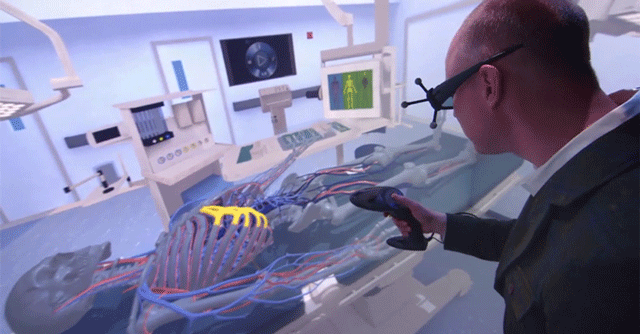
3D virtual simulations assist in human heart implants, brain research


Can the use of realistic 3D simulations of human organs like the heart and brain, transform medical care? Ganesh Sabat, chief executive officer of Mumbai-headquartered Sahajanand Medical Technologies — a cardiovascular implant manufacturer, believes it can.
An early user of virtual simulation technology in the country, the biggest advantage of this technology in the field of medical implant manufacturing is that it reduces the time to do an implant, according to Bapat. “Physical design tests for such products can take 3-4 years. But virtual simulation models reduce the time to find the right design of an implant and subsequently test its strength and durability to just 3-4 months,” he explained.
This technology platform, which was showcased by French technology company Dassault Systemes at the recently-concluded Consumer Electronics Show (CES), is christened the 'Living Heart'. Frederic Vacher, head of innovation at Dassault’s global 3DExperience laboratory, said the platform’s biggest strength lies in the accurate rendition of a 3D model of an organ — produced through conventional medical imaging inputs.

“The clone replicates all the physics of the cardiovascular muscles, allowing the virtual twin of the heart to act like the real one, including blood flow and electric impulse simulation of the cardiac vessels,” Vacher explained.
It is this blood flow simulation that is critical for an implant manufacturer such as Sahajanand. “The basis of the technology is finite element analysis (FEA). If you’re trying to build a bridge, you’ll have many components for it. What we need to know for this are factors such as the strength that it can withstand, the duration through which it can do that, and so on. This is why we need simulation models to gauge stress, pressure points and stress distribution properties,” Sabat said.
The heart is one of the most important organs in the human body. Almost 900 gallons of blood pass through arteries daily, which is why a virtual 3D simulation of the heart is a very complex task. Dassault Systemes, as part of its ‘3DExperience’ platform, offers its so-called 'Virtual Twins'. As the name suggests, the idea behind the technology is to recreate highly accurate versions of a real object.

According to the Dassault Systemes website, the Living Heart Model and use of virtual patients is expected to "...increase industry innovation and pave the way for faster approvals and quicker patient access to safe, effective new treatments for the world’s leading cause of death – heart disease".
While these 3D simulations are being used to improve the durability of cardiac implants, companies have also begun using them to better understand the human brain and also do drug research. Under its life sciences arm, for instance, Dassault technology powers a number of research initiatives and even commercial ventures in India and around the world — in the pharmaceutical space. “Patient experience is the new frontier in drug development. The global biologics market is worth $375 billion, and 40 percent of pharmaceutical R&D is dedicated to biologic drugs. India, presently, is in the early stages of adoption of this tech,” Deepak NG, managing director at Dassault India, said.
Moreover, while cardiovascular implants have already gone mainstream, another area where the virtual twin technology is contributing is in medical health research. In 2018, the National Institute of Mental Health and Neurosciences (Nimhans) partnered with Dassault and cloud computing simulation platform UberCloud for a non-invasive transcranial neuro-stimulation treatment, which use magnetic pulses to produce electrical impulses to stimulate targeted areas of the human brain. The latter used virtual twins to simulate outcomes for the potential treatment of schizophrenia.

Indian startup BrainSightAI is also working towards potential clinical trials of numerous mental health ailments, using Dassault’s virtual twin simulation platforms as the medium. Laina Emmanuel, chief executive of BrainSightAI, said the virtual twin technology applies conventional, advanced medical imaging into neurological research projects.
“The placement of electrodes in the brain is critical in neuro-modulation therapy. The wrong areas of the brain cannot be stimulated because this can have a major impact. Now, because each brain is different, what we need is a way to apply the current in specific areas, and understand how that would flow through the layers of a brain, how it would affect different brain networks, how it would stimulate the target region of the brain, and finally, how this would affect a patient,” she added.
According to Emmanuel, while neuro-stimulation is done directly on individuals today, the virtual twin platform reduces both time and risk in brain stimulation. She further stated that along with Dassault, BrainSight is also working on “in-silico clinical trials” to develop neurological treatments.

In-silico trials refer to the use of advanced computation platforms to test drugs and treatments, before they are applied to humans.
According to Vacher, the virtual twin platform is being applied at a nano-particle scale. The latter seeks to virtualise molecular design for application in pharmaceutical research. One of its already-seen implementations has been seen in the development of the covid-19 vaccine, where molecular virtualisation was used by pharma majors Pfizer-BioNTech and Moderna during their research and testing phases.
